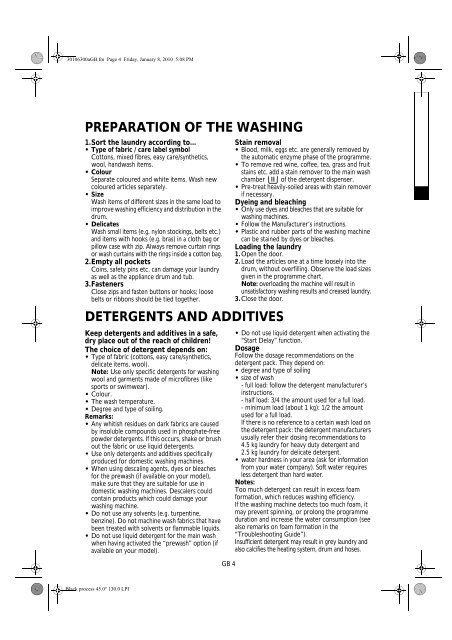KitchenAid Pure 1480 - Pure 1480 EN (859201412000) Istruzioni per l'Uso
KitchenAid Pure 1480 - Pure 1480 EN (859201412000) Istruzioni per l'Uso
KitchenAid Pure 1480 - Pure 1480 EN (859201412000) Istruzioni per l'Uso
Create successful ePaper yourself
Turn your PDF publications into a flip-book with our unique Google optimized e-Paper software.
30106300aGB.fm Page 4 Friday, January 8, 2010 5:08 PM<br />
PREPARATION OF THE WASHING<br />
1.Sort the laundry according to...<br />
• Type of fabric / care label symbol<br />
Cottons, mixed fibres, easy care/synthetics,<br />
wool, handwash items.<br />
• Colour<br />
Separate coloured and white items. Wash new<br />
coloured articles separately.<br />
•Size<br />
Wash items of different sizes in the same load to<br />
improve washing efficiency and distribution in the<br />
drum.<br />
• Delicates<br />
Wash small items (e.g. nylon stockings, belts etc.)<br />
and items with hooks (e.g. bras) in a cloth bag or<br />
pillow case with zip. Always remove curtain rings<br />
or wash curtains with the rings inside a cotton bag.<br />
2.Empty all pockets<br />
Coins, safety pins etc. can damage your laundry<br />
as well as the appliance drum and tub.<br />
3.Fasteners<br />
Close zips and fasten buttons or hooks; loose<br />
belts or ribbons should be tied together.<br />
DETERG<strong>EN</strong>TS AND ADDITIVES<br />
Keep detergents and additives in a safe,<br />
dry place out of the reach of children!<br />
The choice of detergent depends on:<br />
• Type of fabric (cottons, easy care/synthetics,<br />
delicate items, wool).<br />
Note: Use only specific detergents for washing<br />
wool and garments made of microfibres (like<br />
sports or swimwear).<br />
• Colour.<br />
• The wash tem<strong>per</strong>ature.<br />
• Degree and type of soiling.<br />
Remarks:<br />
• Any whitish residues on dark fabrics are caused<br />
by insoluble compounds used in phosphate-free<br />
powder detergents. If this occurs, shake or brush<br />
out the fabric or use liquid detergents.<br />
• Use only detergents and additives specifically<br />
produced for domestic washing machines.<br />
• When using descaling agents, dyes or bleaches<br />
for the prewash (if available on your model),<br />
make sure that they are suitable for use in<br />
domestic washing machines. Descalers could<br />
contain products which could damage your<br />
washing machine.<br />
• Do not use any solvents (e.g. turpentine,<br />
benzine). Do not machine wash fabrics that have<br />
been treated with solvents or flammable liquids.<br />
• Do not use liquid detergent for the main wash<br />
when having activated the “prewash” option (if<br />
available on your model).<br />
GB 4<br />
Stain removal<br />
• Blood, milk, eggs etc. are generally removed by<br />
the automatic enzyme phase of the programme.<br />
• To remove red wine, coffee, tea, grass and fruit<br />
stains etc. add a stain remover to the main wash<br />
chamber of the detergent dispenser.<br />
• Pre-treat heavily-soiled areas with stain remover<br />
if necessary.<br />
Dyeing and bleaching<br />
• Only use dyes and bleaches that are suitable for<br />
washing machines.<br />
• Follow the Manufacturer’s instructions.<br />
• Plastic and rubber parts of the washing machine<br />
can be stained by dyes or bleaches.<br />
Loading the laundry<br />
1. Open the door.<br />
2. Load the articles one at a time loosely into the<br />
drum, without overfilling. Observe the load sizes<br />
given in the programme chart.<br />
Note: overloading the machine will result in<br />
unsatisfactory washing results and creased laundry.<br />
3. Close the door.<br />
• Do not use liquid detergent when activating the<br />
“Start Delay” function.<br />
Dosage<br />
Follow the dosage recommendations on the<br />
detergent pack. They depend on:<br />
• degree and type of soiling<br />
• size of wash<br />
- full load: follow the detergent manufacturer’s<br />
instructions.<br />
- half load: 3/4 the amount used for a full load.<br />
- minimum load (about 1 kg): 1/2 the amount<br />
used for a full load.<br />
If there is no reference to a certain wash load on<br />
the detergent pack: the detergent manufacturers<br />
usually refer their dosing recommendations to<br />
4.5 kg laundry for heavy duty detergent and<br />
2.5 kg laundry for delicate detergent.<br />
• water hardness in your area (ask for information<br />
from your water company). Soft water requires<br />
less detergent than hard water.<br />
Notes:<br />
Too much detergent can result in excess foam<br />
formation, which reduces washing efficiency.<br />
If the washing machine detects too much foam, it<br />
may prevent spinning, or prolong the programme<br />
duration and increase the water consumption (see<br />
also remarks on foam formation in the<br />
“Troubleshooting Guide”).<br />
Insufficient detergent may result in grey laundry and<br />
also calcifies the heating system, drum and hoses.<br />
Black process 45.0° 130.0 LPI
















